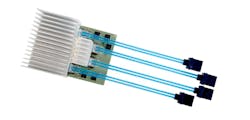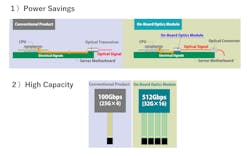On-board optics module boosts data center bandwidth, cuts power consumption
Japan's Kyocera Corporation this month announced that it has developed a prototype On-Board Optics Module that achieves world-record bandwidth of 512 gigabits per second (Gbps). The module is expected to support high-speed network applications, such as data centers. Additionally, by converting electrical signals into optical signals, the company states that the module uses much less power than conventional alternatives, so will help decrease power consumption and promote sustainability in data centers.
Kyocera’s prototype module is miniaturized for installation on a printed circuit board near the processor, allowing electronic data to be converted into optical signals instantaneously. The product is designed to create unprecedented improvements in signal-to-noise ratio, virtually eliminating the signal loss caused by conventional electrical conductors. As a result of these technological advances, Kyocera’s On-Board Optics Module has achieved world-record bandwidth of 512 Gbps.
512 Gbps bandwidth is currently the world record using the Peripheral Component Interconnect Express 5.0 (PCIe gen5) extended interface standard, according to Kyocera research from September 2022. The new module is expected to help data centers and supercomputers save power while increasing bandwidth and data transfer rates.
Development background
AI, IoT, and expanding 5G communication services are creating a rapid increase in internet traffic worldwide and unprecedented demand for high-speed, large-bandwidth data centers. However, the data center industry is fast becoming a leading consumer of electricity, so reducing facilities' power consumption is also a major issue for society. Geared in response to these challenge, Kyocera’s new on-board optics module features a miniaturized form factor that can be board-mounted inside the server near the processor, enabling power-saving signal transmission by converting electronic data into optical signals instantaneously.
In the future, to support innovations like autonomous driving and the metaverse, more data centers will need to be built to reduce latency and shorten the distance to end-users. The prototype’s transmission bandwidth of 512 Gbps will substantially improve data center speed and capacity. Kyocera adds that the new module contributes to miniaturization by achieving high speed and large capacity in a small form factor, allowing data centers to be built in urban and other higher-population-density areas.
Prototype key features
- 1) Power Savings - Copper conductors are usually needed to send and receive electrical signals; however, even the best copper conductors introduce electrical resistance that results in signal loss. Kyocera’s new on-board optics module converts the electrical signal from the processor into a low-loss optical signal on the circuit board. In addition, data can be received as optical signals until just before reaching the processor, further reducing signal loss and power consumption.
- 2) World-Record Bandwidth, Larger Capacity - The largest bandwidth among on-board optics on the market today is 100 Gbps; Kyocera’s module achieves a world-record 512 Gbps bandwidth, over 5x greater than conventional products. Such large bandwidth is possible because the module uses a Low-Temperature Co-fired Ceramic (LTCC) mounting substrate developed by Kyocera, which offers exceptional material characteristics, such as fine wiring, low dielectric constant, multilayering, and thermal conductivity.
- 3) Space Savings - Kyocera’s module measures just 43.5 x 30 x 8.1 mm, allowing world-record 512 Gbps bandwidth for high-capacity data transmission even in a limited space. This will help customers build faster, more space-efficient data centers.
Kyocera said it will continue to test its On-Board Optics Module technology with partner companies to achieve commercialization as early as possible. In addition, the company pledged to continue "to engage in R&D to develop new products that contribute to solving the challenges of today’s ever-evolving digital society."
For more news, projects, and profiles in the ICT cabling and connectivity industry, subscribe to CI&M’s newsletter and follow us on LinkedIn, Twitter, and Facebook.
About the Author
Matt Vincent
Senior Editor
Matt Vincent is a B2B technology journalist, editor and content producer with over 15 years of experience, specializing in the full range of media content production and management, as well as SEO and social media engagement best practices, for both Cabling Installation & Maintenance magazine and its website CablingInstall.com. He currently provides trade show, company, executive and field technology trend coverage for the ICT structured cabling, telecommunications networking, data center, IP physical security, and professional AV vertical market segments. Email: [email protected]


